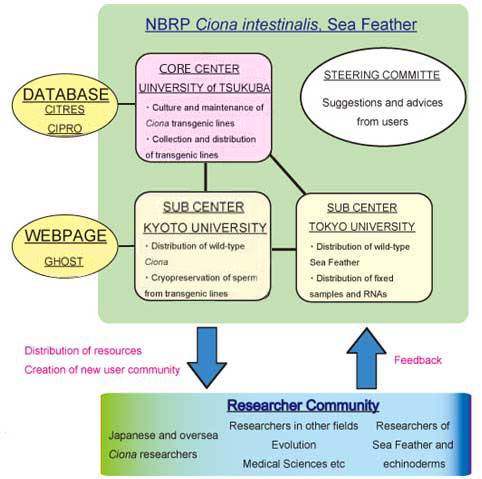National BioResource Project
 Ciona intestinalis / Oxycomanthus japonicus
Ciona intestinalis / Oxycomanthus japonicus
Last update: December, 2011


Center
Shimoda Marine Research Center, University of TsukubaInaba Kazuo

〒415-0025 5-10-1, Shimoda, Shizuoka
Tel : +81-558-22-1317
Fax : +81-558-22-0346
Objectives
Marine invertebrates have contributed to studies of biology, including cell biology, developmental biology, physiology, reproductive biology, ecology, and evolutionary biology.
Two marine organisms, the urochordate ascidian Ciona intestinalis and the echinoderm feather star Oxycomanthus japonicus, have been selected as objects of the National Bio-Resource Project.
[Ciona intestinalis] In addition to their unique evolutionary position as invertebrate chordates, ascidians provide a simple experimental system to investigate molecular mechanisms underlying development, reproduction, endocrinology, and physiology. In particular, their tadpole-type larva, which has a notochord and a dorsal neural tube, represents the basic chordate body plan. Ciona intestinalis is the seventh animal of which draft genome was decoded in 2002. The approximately 160-Mb genome is estimated to contain -16,000 protein-coding genes. Together with the genome information, cDNA resources as well as information of expression profiles of genes and proteins have been accumulated. In addition, C. intestinalis is the only marine invertebrate that has the advantages necessary for developmental genetics: the application of transgenic technique and Minos-based mutagenesis and established inland culture system. Mutagenesis is carried out by the Minos transposon. Insertional mutant strains and a variety of marker lines that express tissue-specific reporter genes are available. C. intestinalis is now an indispensable model organism for world-wide research communication in life science. For research support, Kyoto University and Shimoda Marine Research Center, University of Tsukuba, collaborate in NBRP resource project for collection, maintenance and distribution of wild and transgenic lines.
[Oxycomanthus japonicus] Echinoderms are one of the major phyla in deuterostomes and important for understanding evolution of deuterostomes. Sea urchins, sea stars and sea cucumbers have been studied as representative echinoderms because their high availability; however, these animals lost some characteristics of original echinoderms. Crinoids are considered to be the most basal group of extant echinoderm classes. They possess a well developed aboral nervous system containing a ganglion, which degenerated in the echinoderms except for the crinoids. Also, crinoids are known for their strong regenerative capacities which are dependent on the nervous system. Thus, crinoids are potentially important model organisms for evolutionary developmental biology and regenerative biology. However, very limited information has been accumulated because of difficulty of its collection. Even the spawning season has not been identified in most of the species of crinoids. Among crinoids, the feather star, Oxycomanthus japonicus, inhabits relatively shallow rocky seashore in the tip of Miura peninsula. We have succeeded in cultivating of O. japonicus up to sexually mature adults on a large scale. O. japonicus is now another model organism of echinoderm. For research support, Misaki Marine Biological Station, University of Tokyo, participates in National Bio Resource Project for collection, maintenance and distribution of fixed larvae, juveniles and adults, as well as cDNA libraries and arrayed BAC library of O. japonicus.
[Ciona intestinalis] In addition to their unique evolutionary position as invertebrate chordates, ascidians provide a simple experimental system to investigate molecular mechanisms underlying development, reproduction, endocrinology, and physiology. In particular, their tadpole-type larva, which has a notochord and a dorsal neural tube, represents the basic chordate body plan. Ciona intestinalis is the seventh animal of which draft genome was decoded in 2002. The approximately 160-Mb genome is estimated to contain -16,000 protein-coding genes. Together with the genome information, cDNA resources as well as information of expression profiles of genes and proteins have been accumulated. In addition, C. intestinalis is the only marine invertebrate that has the advantages necessary for developmental genetics: the application of transgenic technique and Minos-based mutagenesis and established inland culture system. Mutagenesis is carried out by the Minos transposon. Insertional mutant strains and a variety of marker lines that express tissue-specific reporter genes are available. C. intestinalis is now an indispensable model organism for world-wide research communication in life science. For research support, Kyoto University and Shimoda Marine Research Center, University of Tsukuba, collaborate in NBRP resource project for collection, maintenance and distribution of wild and transgenic lines.
[Oxycomanthus japonicus] Echinoderms are one of the major phyla in deuterostomes and important for understanding evolution of deuterostomes. Sea urchins, sea stars and sea cucumbers have been studied as representative echinoderms because their high availability; however, these animals lost some characteristics of original echinoderms. Crinoids are considered to be the most basal group of extant echinoderm classes. They possess a well developed aboral nervous system containing a ganglion, which degenerated in the echinoderms except for the crinoids. Also, crinoids are known for their strong regenerative capacities which are dependent on the nervous system. Thus, crinoids are potentially important model organisms for evolutionary developmental biology and regenerative biology. However, very limited information has been accumulated because of difficulty of its collection. Even the spawning season has not been identified in most of the species of crinoids. Among crinoids, the feather star, Oxycomanthus japonicus, inhabits relatively shallow rocky seashore in the tip of Miura peninsula. We have succeeded in cultivating of O. japonicus up to sexually mature adults on a large scale. O. japonicus is now another model organism of echinoderm. For research support, Misaki Marine Biological Station, University of Tokyo, participates in National Bio Resource Project for collection, maintenance and distribution of fixed larvae, juveniles and adults, as well as cDNA libraries and arrayed BAC library of O. japonicus.
Organization

Available Resources
Ciona intestinalis:
Oxycomanthus japonicus:
- Wild-type adults; mutant strains including swimming juvenile (sj); marker lines for larval muscle, notochord, epidermis, and others; cDNA clones.
Oxycomanthus japonicus:
- Wild-type adults; cDNA clones; BAC library; fixed embryos and larvae.
Distribution / Deposition
Research Result
Committee
Related Sites
http://ghost.zool.kyoto-u.ac.jp/bunshi/links/
http://www.shimoda.tsukuba.ac.jp/~inaba/theme/proteomics.html
Collaboration
INRA, MSNC group, DEPSN, UPR2197, Institut Fessard, CNRS, Gif-sur-Yvette, France
The Graduate University for Advanced Studies, Sokendai Hayama, National Institute of Genetics



